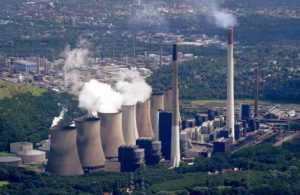7 Ways to Generate Electricity Explained
Ways to generate electricity are; photoelectric conversion, electrochemical reaction, fuel combustion, direct kinetic energy conversion, direct heat capture, heat harvesting, friction and pressure.
This article discusses the ways to generate electricity, as follows;
1). Photoelectric Conversion (as one of the Ways to Generate Electricity)
Photoelectric conversion is the process by which solar energy is converted to electricity.
This method is unique as one of the ways to generate electricity from renewable energy. It is based on the ‘photoelectric effect’, which is a phenomenon whereby energy from solar radiation, activates electrons as it strikes a surface, causing these electrons to flow and create electricity [13].
Photoelectric conversion is also unique as a clean method of electricity generation, compared to other methods. The use of this method reduces the risk of environmental degradation through air quality decline, greenhouse emission and global warming [6].
As a result, photoelectric electricity generation is recommended as one of the measures to achieve sustainability in the energy sector. It is also associated with innovative technologies like artificial intelligence and smart house technology.
In order to generate electricity using this method, a solar panel or solar collector is needed. Solar panels are composed of semiconductor material like silicon, which captures solar radiation and converts it to electricity through a photoelectric process [4].
The main drawback of photoelectric electricity generation is the fact that it is effective only in the daytime. To provide electricity at night, a backup system like a portable electric generator or solar battery is needed.
Energy efficiency of photoelectric electricity generation is also low. The average efficiency of solar photovoltaic cells does not usually exceed 25% [9].
These drawbacks imply that photoelectric method is not yet reliable as an independent source of electricity. However, continuous research, development and technological advancement are leading to improved solar-based electricity.

2). Electrochemical Reaction
The use of electrochemical method in electricity generation, is based on the concept of electrochemistry, which is concerned with how chemical reactions cause the movement of electrons [1].
Such reactions usually involve transfer of charges between reactants, and are often redox (reduction-oxidation) reactions.
Electricity generation through electrochemical reaction, occurs in an electrochemical cell.
This is a device that is equipped to facilitate electrochemical reactions and transmit the electricity that is generated in the process. Electrochemical cells are composed of metallic electrodes that are immersed in an electrolyte [8].
The principle of electrochemical electricity generation is used in liquid hydrogen-driven systems, fuel cells, and deep cycle batteries.
Challenges of this method include flexibility, cost, and capacity.
3). Fuel Combustion (as one of the Ways to Generate Electricity)
Fuel combustion is one of the most common and effective ways to generate electricity.
Fossil fuel is the most common type of fuel that us used to generate electricity. Up to 80% of electricity on Earth is generated by burning fossil fuels like coal; natural gas and petroleum.
In fossil fuel power plants and electric generators, these fuels undergo combustion to produce heat energy, which is used to generate electricity by electromagnetic induction [11].
Aside fossil fuels, biofuel can be produced from renewable organic matter in a biorefinery, by using any of various biomass conversion methods. This fuel can also be used to generate electricity, although it has less energy density than fossil fuel.
Lastly, nuclear fuel may be also placed in this category. The difference between this type of fuel and other fuels is that it releases nuclear energy in the form of heat, but without actual combustion. Rather nuclear fuel produces heat energy from controlled reactions that occur in a nuclear power plant.
The electromagnetic method of producing electricity in nuclear power plants is similar to that used in biomass and fossil fuel power plants. It is based on kinetic-mechanical conversion, where heat energy is used to rotate a turbine by creating fluid pressure [10].
Fuel combustion as a means of electricity generation, has some disadvantages. The most prominent of these is the environmental impact of extracting, refining and burning fuel.
Environmental impacts of fuel-based electricity generation include greenhouse emission, air pollution, soil and water pollution. The high flammability of most fuels also poses health and safety risks.
In order to mitigate the effects of fuel combustion on the environment, various measures can be taken. These measures are often expensive, and increase the overall cost of using fuel to generate electricity. Examples include carbon tax implementation, advanced soil conservation and water conservation measures, and environmental remediation projects.

4). Direct Kinetic Energy Conversion
Direct kinetic energy conversion refers to methods and sources that produce electricity by converting kinetic energy to mechanical energy and driving a turbine generator.
It is called ‘direct kinetic energy’ because, unlike fuel combustion, there is no stage where heat is produced and converted to kinetic energy. This implies that electricity generation by this method requires fewer energy conversions.
Examples of the direct K.E method include the use of wind turbines, wave power facilities, and hydroelectricity plants.
Of the three, hydropower is the most complex, as it requires construction of water dams and installation of turbines [5]. In wave power facilities, the kinetic energy of ocean waves is converted to mechanical energy that is used to drive a generator. This is similar to the principle of the wind turbine.
The advantage of direct K.E conversion is its simplicity and cleanliness compared to fuel combustion. Because kinetic energy is provided directly, there is no need to produce heat and emit gases that are potentially harmful.
However, the efficiency and reliability of wind, wave and hydropower systems is less than fossil fuel systems.
5). Direct Heat Capture (as one of the Ways to Generate Electricity)
The idea behind heat capture is to generate electricity from already existing heat energy, without the need to produce heat by combustion of a fuel.
Geothermal energy is the most common source of direct heat that can be used in electricity generation.
This heat is stored in a fluid, in subsurface reservoirs. In order to capture the heat, a well is drilled into the geothermal reservoir to extract the fluid. Proper functioning of a geothermal powerplant required temperature of at least 300°F [12].
Because the fluid has been heated and pressurized, it forms vapor that can be used to rotate and turbine and activate an electric generator.
However, it is difficult to achieve energy conservation or efficiency when using this method, due to losses of heat that occur as the fluid is transported from the reservoir to its point of use. Also, the availability of geothermal resources is limited in comparison to other energy sources.
Therefore, geothermal power plants are often supported by a backup heat-source, such as fossil fuel.
To reduce heat loss and increase efficiency, cogeneration facilities are often integrated into geothermal power plants. These facilities can capture waste heat and make it available for other purposes aside electricity.
6). Heat Harvesting
‘Heat harvesting’ is one of the less-known ways to generate electricity.
It refers to the act of collecting or harvesting heat energy from a body, without any direct involvement of the heat source in the electricity generation process.
Heat harvesting differs from heat capture because the latter involves both the heat and the body from which it is harvested (in this case; geothermal fluid). On the other hand, heat harvesting extracts latent heat from a body but does not necessarily involve the body in the remainder of the process of converting heat to mechanical energy and electric power.
A good example of heat harvesting is the use of thermoelectric generators (TEGs) to generate power using heat from the human body [7].
This type of generator usually occurs as a simple conductive device that could be worn on the wrist. However, more advanced heat harvesting technologies can extract body heat through radiation.
The concept of heat harvesting is like cogeneration, in that it harvests waste heat from the body and uses it to generate electricity. However, this method is not reliable to generate any significant amount of power. Rather, it is better suited for small electric loads.
7). Friction and Pressure (as one of the Ways to Generate Electricity)
The use of friction to generate electricity is known as ‘triboelectric’ method [3].
It is based on the principle of static charge accumulation on a surface due to the influence of mechanical energy on electrons. When surfaces are rubbed against each other, the friction between them causes charges to be momentarily mobilized. These charges accumulate within the area of the surface that has been affected by friction.
The accumulated charges can flow through a conductor material, thereby generating electricity.
Various models have been designed to illustrate this concept. However, it is not a reliable method due to very low power output.
The use of pressure to generate electricity is based on piezoelectric principles, which explain the mobilization of electric charges due to stress [2].
This method is possible using piezoelectric materials like quartz and lithium niobate.
It is worth noting that pressure also plays a role in other ways to generate electricity, such as fuel combustion. This is because the mechanical energy that drives the turbine to generate power, works based on pressure application.
At the present, piezoelectricity is relevant only as a scientific concept. It is not practically reliable to produce any significant amount of electricity.
Conclusion
Ways to generate electricity are;
- Photoelectric Conversion
- Electrochemical Reaction
- Fuel Combustion
- Direct Kinetic Energy Conversion
- Direct Heat Capture
- Heat Harvesting
- Friction and Pressure
References
1). Aguilar, P. J. (2016). “Electrochemistry I.” Cubel Consultancy Presentation, Belize Ordinal: 18/2016Affiliation: Cubel Consultancy. Available at: https://doi.org/10.13140/RG.2.1.4591.9126. (Accessed 16 August 2022).
2). Dakhole, A.; Boke, A. K. (2017). “Electrical Energy Harvesting From Mechanical Pressure of Vehicles Using Piezoelectric Generators.” Available at: https://doi.org/10.9790/1676-1202024649. (Accessed 16 August 2022).
3). Galembeck, F.; Burgo, T. A.; Balestrin, L.; Gouveia, R. F.; Silva, C. A.; Galembeck, A. (2014). “Friction, tribochemistry and triboelectricity: Recent progress and perspectives.” RSC Advances 4(109):64280-64298. Available at: https://doi.org/10.1039/c4ra09604e. (Accessed 16 August 2022).
4). Green, M. (2015). “Crystalline Silicon Solar Cells.” Available at: https://doi.org/10.1142/9781848167681_0003. (Accessed 16 August 2022).
5). Isaac, O.; Atoyebi, M. O.; Olatunbosun, A.; Zubair, A. R. (2012). “Installation and Testing of a 5kW Hydropower Turbine.” Available at: https://www.researchgate.net/publication/320622758_Installation_and_Testing_of_a_5kW_Hydropower_Turbine. (Accessed 16 August 2022).
6). Masson, V.; Bonhomme, M.; Salagnac, J.; Briottet, X.; Lemonsu, A. (2014). “Solar Panels reduce both global warming and Urban Heat Island.” Frontiers in Environmental Science 2. Available at: https://doi.org/10.3389/fenvs.2014.00014. (Accessed 16 August 2022).
7). Rosli, N. N.; Mohamed, H. (2018). “Experimental Study on the Use of Thermoelectric Generators in Harvesting Human Body Heat.” International Journal of Engineering & Technology 7(4):264-269. Available at: https://doi.org/10.14419/ijet.v7i4.35.22744. (Accessed 16 August 2022).
8). Salah, R. (2020). “All about the electrochemical cell and its different types.” Available at: https://doi.org/10.13140/RG.2.2.21520.43522. (Accessed 16 August 2022).
9). Saleem, A.; Mehmood, K.; Rashid, F. (2019). “The Efficiency of Solar PV System.” Proceedings of 2nd International Multi-Disciplinary Conference, Gujrat. Available at: https://www.researchgate.net/publication/334277230_The_Efficiency_of_Solar_PV_System. (Accessed 15 August 2022).
10). Soenoko, R.; Stetyarini, P. H.; Gaspari, F. (2018). “Eight curved bladed kinetic water turbine performance.” Available at: https://www.researchgate.net/publication/324526489_Eight_curved_bladed_kinetic_water_turbine_performance. (Accessed 16 August 2022).
11). Thirion, C.; Steyn, J. (2021). “Natural Gas for Power Generation.” Available at: https://www.researchgate.net/publication/354863542_Natural_Gas_for_Power_Generation. (Accessed 16 August 2022).
12). Yang, Z.; Liu, X.; Gluesenkamp, K. R.; Smith, C. D.; Li, J.; Momen, A. M. (2016). “Transported Low Temperature Geothermal Energy for Thermal End Uses—Final Report.” Available at: https://doi.org/10.2172/1337859. (Accessed 16 August 2022).
13). Yousif, M. E. (2015). “The Photoelectric Effects: Radiation Based With Atomic Model.” International Journal of Fundamental Physical Sciences 5(1):18-31. Available at: https://doi.org/10.14331/ijfps.2015.330082. (Accessed 16 August 2022).



